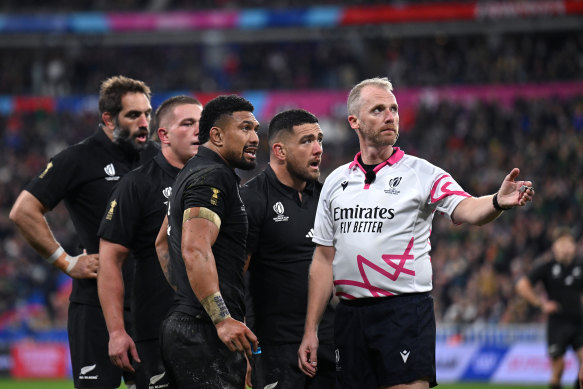This was published 10 months ago
Opinion
Seventeen dead minutes: Why World Rugby had to act after Cup final
Paul Cully
Rugby columnistIt only takes a rewatching of the first Rugby World Cup final of the previous decade to understand why so many supporters are frustrated with the modern game.
Although the New Zealand-France final in 2011 wasn’t regarded as a classic by any means at the time, there was more rugby played in the opening 10 minutes than the entire 2023 final between South Africa and New Zealand.
That’s a subjective view of course, but there is also an objective truth about both games.
Remarkably, the 2023 final took 17 minutes longer to complete. This masthead this week timed both games, with the half-time breaks stripped out, and the 2023 final ran for a touch more than 106 minutes, while the 2011 decider lasted just longer than 89 minutes.
The second half of the 2023 final took 56 minutes to complete, 40 per cent longer than the scheduled running time. The game is battling for eyeballs in an attention economy, but in just more than a decade it has added 17 minutes of nothing to its showpiece event.
Hence, the urgency of the recent World Rugby “Shape of the Game” meetings in London that this week produced a suite of recommendations designed to speed up the game.

Wayne Barnes in charge of the 2023 Rugby World Cup final in Paris.Credit: Getty
There will be debate about each recommendation – positions seem to be entrenched already – but the overall desire to make the game faster hasn’t occurred in a vacuum. World Rugby will be well aware that those extra 17 minutes of TMO checks, slow set-piece set-ups, substitutions, “injuries” and so forth have profoundly changed the game – and likely for the worse.
An increase of five minutes would be understandable – even seven or eight minutes. But 17 minutes is an extraordinary figure, particularly in a game that didn’t have any lengthy stops for injuries (All Blacks No.10 Aaron Cruden’s knee injury in the 2011 final actually added a few minutes to the first half of 45 minutes and 10 seconds).
The extra 17 minutes, therefore, were a direct result of changes made by World Rugby, or to how the game was officiated and/or coached (they also prove the nonsense of using the raw “ball in play” statistic as proof that the modern game is better).
Therefore, it would be wise to be wary of those who argue that World Rugby should be wary of changing the laws because it would mess with the “essence” of the game.
The game has already been changed dramatically, as those 17 minutes show. In my view, any changes would simply restore the game to what it once was.
It desperately needs some pace, or flow, put back into it. Frankly, it was a relief when Wayne Barnes blew the whistle in the World Cup final. That game needed to be put out of its misery.
Further, if World Rugby serves that up again in Australia in 2027, it’ll kill the game in Australia, not save it. Your average Australian sporting punter will take one look at it and mark it as “never to be watched again”.
Some of the World Rugby recommendations look good, specifically the desire to speed up the use of the ball, and potentially the reduction of the number of replacements.
In the 2011 final, both Nicolas Mas of France and Tony Woodcock of New Zealand played the full 80 minutes, so it’s clearly possible to condition strong scrummagers to safely play more than an hour.
Brendan Morris, the SANZAAR chief executive who attended the “Shape of the Game” meetings, told the Herald last week: “There’s an acknowledgement that there’s a reset that’s needed ... from a fan engagement point of view for financial sustainability.
“The game really needs a reset and there’s a broad acknowledgement around that.”
The job for World Rugby is to be relentless about turning that sentiment into concrete changes. Rugby needs to get faster, because the 2023 Rugby World Cup final was a complete dead-end.
Sports news, results and expert commentary. Sign up for our Sport newsletter.
Watch all the action from the 2024 Super Rugby Pacific season, with every match ad-free, live and on demand on Stan Sport.